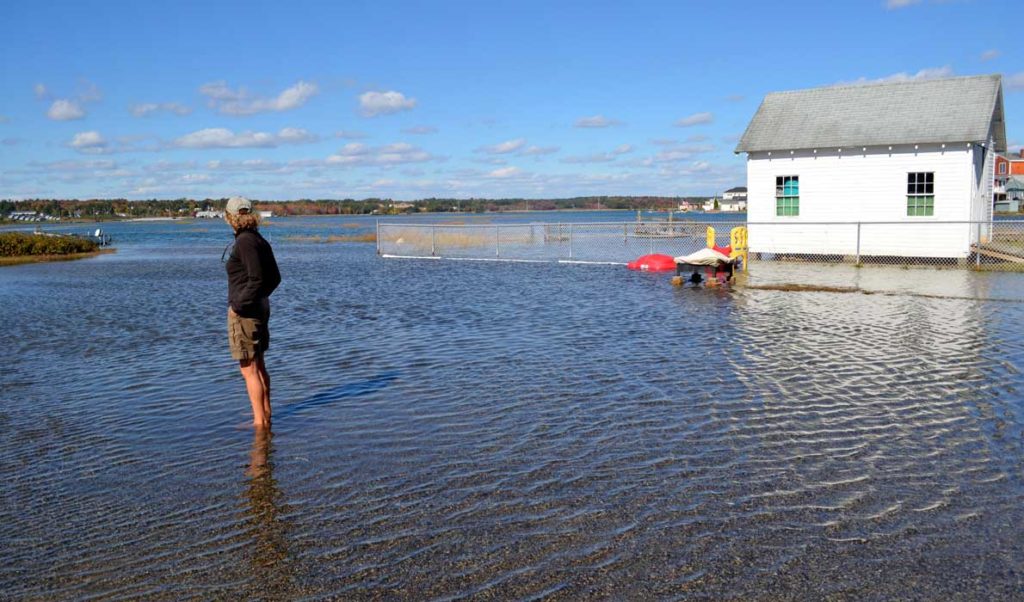In an overview of climate change science at the public forum held in advance of the Arctic Council meetings in Portland, Sen. Angus King concluded that “something serious is happening, and it’s happening faster than we thought.”
Later in the day, a panel of scientists gave the details on the effect of 400-plus parts per million atmospheric concentrations of carbon dioxide and associated warming in the Arctic. Aspects of the “unraveling,” as laid out by Rafe Pomerance of Arctic21, include melting sea and land-based ice, decreased snow cover and thawing permafrost.
Sea ice is the big story.
Declining stability of Arctic sea ice, especially since the mid-20th century, has “opened up” the North Pole. Typically, September is the time of lowest sea ice extent in the Arctic, part of what Paul Mayewski, director of the Climate Change Institute at the University of Maine, called “one of the greatest seasonal cycles on Earth.”
But with the summer open-water season now twice as long in some areas, the Arctic is experiencing a magnitude of change not seen in 15,000 years when the last Ice Age ended.
Each September since 2002, open water has appeared, especially on the Pacific side. The lack of ice has profound influence on the rest of the planet.
“What happens in the Arctic doesn’t stay in the Arctic,” said David Balton, deputy assistant secretary for oceans and fisheries with the U.S. State Department.
Without Arctic sea ice, the difference in temperature between land and air is less, weakening the westerly winds (which are responsible for our variable weather patterns) and strengthening the north-south exchange of air, which leads to extreme events and more persistent weather (creating features such as the “polar vortex”).
Without Arctic sea ice, more light gets into the water, increasing phytoplankton and potentially shifting the location of this primary production and the fisheries it supports. Even bottom temperatures are warming, affecting the marine community beneath the surface that supports animals like eiders, walrus and gray whales, according to Paty Matrai of the Maine-based Bigleow Laboratory for Ocean Sciences.
Ice on land, such as glaciers and the Greenland ice sheet, is melting, too, contributing freshwater to the oceans. Freshwater also comes from rivers, even more so now that more precipitation falls as rain instead of snow.
All of this fresh water increases ocean stratification, limiting the formation of the deep, cold water layer that circulates around the Atlantic and directly affects the Gulf of Maine.
Matrai described a “polar amplification of global climate change,” because of the Arctic’s connection to Earth’s climate system and the feedback loops that are occurring.
Melting sea ice and glaciers leave larger areas of dark, open water and exposed land, which absorb more solar radiation and further accelerate melting. Thawing permafrost releases more carbon and methane into the heat-trapping layer that is further cooking the planet.
As scientists map the floor beneath the new sea, and natural resource extractors maneuver for profitable positions, four million people who live north of the Arctic circle face imminent changes to their home ground. The rate of change, and “tipping points” such as rapid ice melt, storms, fire, insects and disease, will determine whether their response is resilience, migration or transformation, said Matrai.
Craig Fleener, a Gwich’in from Fort Yukon, Alaska, described the beauty of the landscape and the experiences of his people, where 30 communities are at risk and contemplating moving. He also noted that Native peoples worldwide have a long history of adapting to rapid and dramatic change, of transforming.
Arctic residents—represented on the Arctic Council via associations of Aleut, Athabascan, Gwich’in, Inuit, Russian, and Saami peoples—are the authorities on what is going on in the North, according to Balton. Anne Henshaw of the Oak Foundation emphasized the importance of indigenous knowledge to science past and future. Alaska state Rep. Bob Herron agreed.
“Science must respect and integrate the culture and knowledge of Arctic people,” he said.





